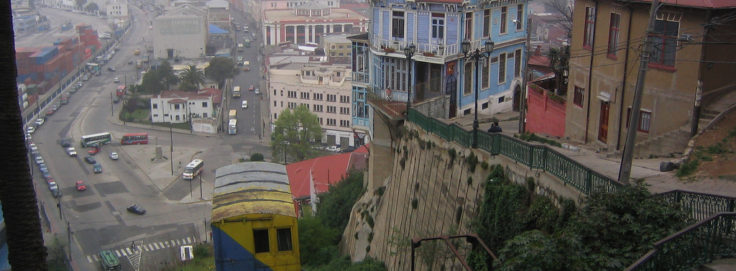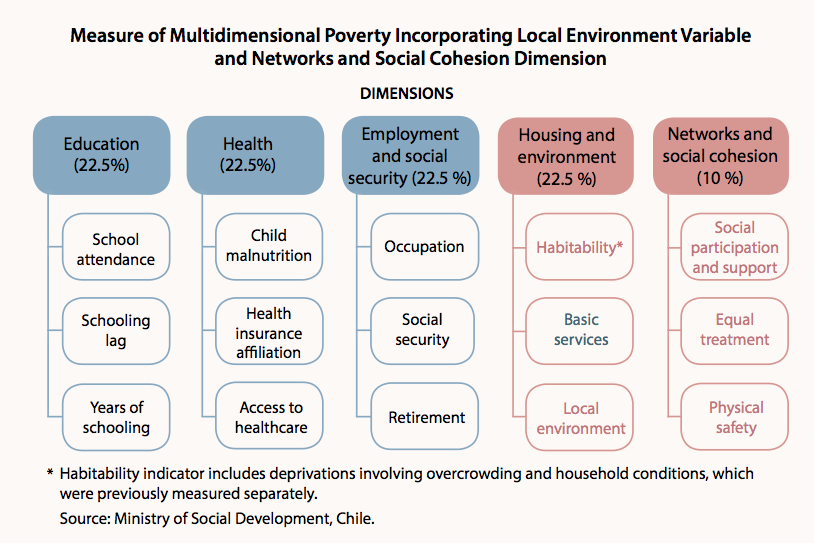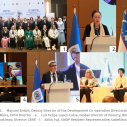
Search
How Was the Chilean Multidimensional Poverty Index Created?

The Multidimensional Poverty Index in Chile (MPI-CL) was the product of a broad dialogue that brought people from different professional and political backgrounds together. What bodies were established to develop the MPI-CL? The following article provides some of the highlights of this process.
Chile began exploring the idea of incorporating a multidimensional poverty index into their official poverty measures in 2009, towards the end of Michelle Bachelet’s first administration. A crisis developed in 2012 when the validity of the data on poverty was called into question, triggering a need to review the measures. The president at that time, Sebastián Piñera, brought together a panel of experts from various organisations and political backgrounds to participate in what was known as the Presidential Advisory Commission of Experts to Update Poverty and Extreme Poverty Lines (Comisión Asesora Presidencial de Expertos para la Actualización de la Línea de la Pobreza y la Pobreza Extrema), whose mission was to brief the president on all aspects of measuring poverty and extreme poverty and to offer proposals on the matter.
Commission to Measure Poverty
The commission was created in December of 2012 and comprised nine people from academia, non-governmental organisations, multilateral organisations, and government, all of them experts on poverty matters. The body engaged in dialogue with a broad group of people from various civil society organisations, Congress, governmental agencies, universities, and international organisations and specialists.
The commission’s president was Rodrigo Jordán, vice president of the Foundation for Overcoming Poverty (Fundación para la Superación de la Pobreza), an institution tasked with generating information and proposals for overcoming poverty and social exclusion. This foundation had worked on the idea of creating social thresholds for Chile based on a multidimensional perspective on poverty. This perspective allowed for internal discussion at the commission to include subjects beyond income.
After 13 months of work, the commission presented two proposals. The first suggested updating the monetary poverty measure, given that the existing one had been created in 1987 and had not been revised since then. Therefore, it did not reflect the current consumption patterns of households in Chile.
The second proposal stated that a new measure of multidimensional poverty, based on the Alkire-Foster methodology, should be incorporated into Chile’s official statistics and identified the dimensions this should include.
The commission proposed 14 indicators to measure deprivations in five dimensions: education, health, employment and social security, housing, and local environment and networks. Further, it recommended giving equal consideration to each of the dimensions, and identified as deprived those households with 33% or more of the deprivations.
The process of creating the MPI-CL was a very rich experience in terms of involvement at an institutional level and the broad participation of civil society. The different bodies that were created were non-governmental and independent, with people from different political and professional backgrounds.
This report was delivered to President Piñera at the end of his administration (January 2014). Its implementation, by the Ministry of Social Development, went into effect therefore under the second administration of President Michelle Bachelet.
The ministry took the commission’s recommendations and generally adopted the new proposals for measuring monetary poverty. For the multidimensional measures, an Interinstitutional Technical Panel (MTI, Mesa Técnica Interinstitucional) was established by the Ministry of Social Development and the National Institute of Statistics, and advised by the Economic Commission for Latin America and the Caribbean (ECLAC, Comisión Económica para América Latina y el Caribe, CEPAL). The ministry also received technical advice from the Oxford Poverty and Human Development Initiative (OPHI).
This group of experts analysed the recommended indicators and made slight revisions to the original proposal. For example, the use of some indicators was delayed because of technical problems with some of the available data. In December of 2014, a seminar was held to introduce the methodology of the MPI-CL, which comprised four dimensions: education, health, employment and social security, and housing, each of them having three indicators. Through this MPI-CL, a person with deprivations in at least three of the 12 indicators – or the equivalent of being deprived in one dimension – would be considered multidimensionally poor.
Furthermore, it was stated that the local environment and networks dimension would be incorporated into the next measure because the data in the Casen Survey on this subject were not adequate. The government committed to presenting a revised measure in the short term in response to a request that civil society made through the commission.
The Reformulation of the MPI-CL to Incorporate a New Dimension
For an in-depth analysis of how to measure the local environment and networks dimension proposed by the Presidential Commission in April of 2015, the Ministry of Social Development created the Ministerial Advisory Committee on the Local Environment and Networks (Comité Asesor Ministerial Entorno y Redes) comprising seven representatives from civil society and academia who were specialists in the subject. The committee worked over a period of three months, using the commission’s report as a basis to measure poverty. The final report was presented in August of 2016.
The committee analysed the problems that available indicators on the local environment and networks had and proposed nine new questions. The ministry began to work from this basis to incorporate them into the MPI-CL, taking into account the contributions of various public institutions and the recommendations of the Casen 2015 Panel of Experts.
At the end of the project, the Ministry of Social Development modified the original MPI-CL to accommodate these new indicators. The resulting new multidimensional measure includes five dimensions: education, health, employment and social security, housing and local environment, and networks and social cohesion. Each dimension comprises three indicators, adding up to a total of 15.
Upon adding the new indicators to the five dimensions, the government also showed the figures from the first version of the MPI-CL, that is, without incorporating the fifth dimension or the local environment variable, to make the figures more transparent and to maintain the data series. The new version of the MPI-CL was well received by the general public, as all aspects requested by the commission were included.
Consensus for Measuring Poverty
The process of creating the MPI-CL was a very rich experience in terms of involvement at an institutional level and the broad participation of civil society. The different bodies that were created were non-governmental and independent, with people from different political and professional backgrounds. Academics, politicians, and members of civil society working on the frontlines in vulnerable zones all participated in the process, an approach that created a broad consensus on measuring poverty and its dimensions. This was evident both in the Presidential Commission and in the Ministerial Commission charged with proposing the reformulation of the indicators.
All of these factors make the Chilean case of great interest to other countries. Not only do they shine a light on an interactive path for designing a multidimensional poverty index, but they also show that these kinds of indices can be modified with a minimum of controversy, as long as it is done with transparency in order to avoid suspicion.
Foto: Phil Whitehouse.

















